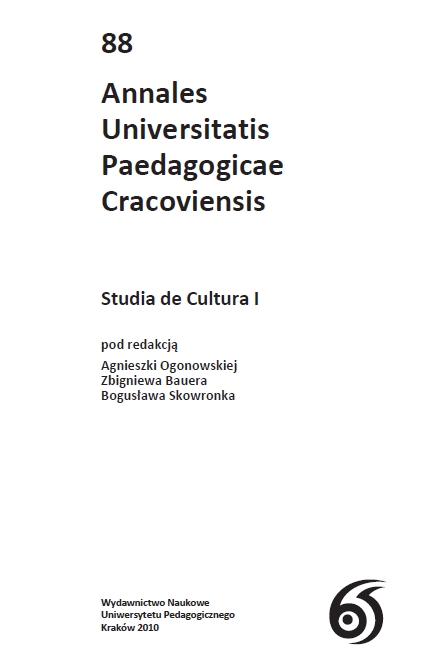Abstrakt
Peepshow, prompter, bluebox - three meta-metaphors of the subject - infosphere relation
The article describes a specific kind of relation between the subject (considered to be a user of the new media) and digitally created meanings (which build the infosphere) that can be seen as competition. An opportunity to look for dimensions and ranges of this competition is offered by the analysis of history and the way of functioning of three media technologies: peepshow, blue box and prompter. These are treated in the paper as metaphors of the contemporary infosphere prosumer’s condition. The author studies methodological possibilities of analyzing this relation and focuses on presenting the problem in the historical perspective.
Bibliografia
Baltzer R. (1998), Peepshows. A Visual History, New York.
Zobacz w Google Scholar
Brook P. (1977), Pusta Przestrzeń, przeł. W. Kalinowski, Warszawa.
Zobacz w Google Scholar
Chardin de T. (1985), Zarys wszechświata personalistycznego i inne pisma, przeł. J. i G. Fedorowscy, Warszawa.
Zobacz w Google Scholar
CIBER (2008), Information Behaviour of the Researcher of the Future. Executive Summary, http://www.ucl.ac.uk/infostudies/research/ciber/downloads/ggexecutive.pdf
Zobacz w Google Scholar
Davenport T.H., Prusak L. (1997), Information Ecology: Mastering the Information and Knowledge Environment, New York.
Zobacz w Google Scholar
Disney Press Release, Generation XD-Disney Releases Biggest Ever Study of Tweens in Europe, 2010, http://www.smartmoney.com/news/pr/?story=PR-20100111-000088
Zobacz w Google Scholar
Dyens O. (2001), Metal and Flash. The Evolution of Man: Technology Takes Over, MIT Press, Cambridge Mass.
Zobacz w Google Scholar
Gitelman L., Pingree G.B. (2003), New Media, 1740–1915, Cambridge Mass.
Zobacz w Google Scholar
Haraway D. (1991), A Cyborg Manifesto: Science, Technology, and Socialist-Feminism in the Late Twentieth Century, [w:] Simians, Cyborgs and Women: The Reinvention of Nature, New York, pp. 149–181, dostępne na http://www.stanford.edudept/HPS/Haraway/Cyborg-Manifesto.html.
Zobacz w Google Scholar
Haraway D. (2008), When Species Meet, Minneapolis–London.
Zobacz w Google Scholar
Hayles N.K. (2009), Stan wirtualności, [w:] Ekrany piśmienności. O przyjemnościach tekstu w epoce nowych mediów, red. A. Gwóźdź, przeł. J. Mach, Warszawa.
Zobacz w Google Scholar
Heim M. (2001), Erotyczna ontologia cyberprzestrzeni, przeł. A. Piskorz, [w:] Widzieć, myśleć, być, red. A. Gwóźdź, Kraków.
Zobacz w Google Scholar
Kittler F. (1993), Es gibt keine Software Draculas Vermächtnis: Technische Schriften. Leipzig, w angielskiej wersji (There is No Software) dostępny na http://hydra.humanities.uci.edu/kittler/software.html
Zobacz w Google Scholar
Klingberg T. (2009), The Overflowing Brain Information Overload and the Limits of Working Memory, New York.
Zobacz w Google Scholar
Lanier J. (2006), Digital Maoizm. The Hazards of New Online Collectivism, “Edge. The Third Culture” 30.05.http://www.edge.org/3rd_culture/lanier06/lanier06_index.html [25.01.2010].
Zobacz w Google Scholar
Lanier J. (2010), You Are Not a Gadget: A Manifesto, Allen Lane.
Zobacz w Google Scholar
Latour B. (2009), Polityka natury, przeł.. A. Czarnecka, Warszawa.
Zobacz w Google Scholar
Latour B. (2005), Reassembling the Social: An Introduction to Actor-Network-Theory, Oxford.
Zobacz w Google Scholar
Laurel B. (1993), Computer as Theatre, Reading MA.
Zobacz w Google Scholar
Lynn R. (2005), The Sexual Revolution 2.0: Getting Connected, Upgrading Your Sex Life, and Finding True Love -- or at Least a Dinner Date -- in the Internet Age, Amorata, Berkley CA.
Zobacz w Google Scholar
Manovich L. (2006), Język nowych mediów, przeł. P. Cypryański, Warszawa
Zobacz w Google Scholar
McKinnon S.M., Bruns W.J. (1992), The Information Mosaic, Boston Mass.
Zobacz w Google Scholar
Moss P., Peepshow Stories, http://peepshowstories.com
Zobacz w Google Scholar
Murray J.H. (1997), Hamlet on the Holodeck. Future of Narrative in Cyberspace, Cambridge Mass.
Zobacz w Google Scholar
Negroponte N. (1997), Cyfrowe życie: jak się odnaleźć w świecie komputerów, przeł. M. Łakomy, Warszawa.
Zobacz w Google Scholar
Naughton R., Adventures in Cybersound, The Peep Show and Toy Theatre, http://www.acmi.net.au/AIC/PEEP_SHOW.html [5.10.2009].
Zobacz w Google Scholar
Qvortrup L. (2003), Hypercomplex Society, New York, Bern, Berlin, Bruxelles, Frankfurt/M., Oxford, Wien.
Zobacz w Google Scholar
Smith M.R., Marx L. (1994), Does Technology Drives History. The Dilemma of Technological Determinism, Cambridge Mass.
Zobacz w Google Scholar
Virillo P. (2006), Bomba megabitowa, przeł. J. Staszewski, Warszawa.
Zobacz w Google Scholar
Umland S.L., Wessel K. (2004), Cassandra Among the Cyborgs, or, the Silicon Termination Notice, [w:] Prefiguring Cyberculture, An Intellectual History, A. Cavallaro, D. Tofts, A. Jonson (red). MIT Press, Cambridge Mass.
Zobacz w Google Scholar
Williams R., Edge D. (1996), The Social Shaping Of Technology, “Research Policy” 25, s. 856–899,
Zobacz w Google Scholar
Weynants T., Peepshow. Boîte d’optique. Xi yang jing. Rarekiek mondo nuovo. Schene rariteten. Guckkasten “what the butler saw”/optical viewing boxes and their images/ 3-d day & night effects, http://www.visual-media.eu/vue-optique.html [25.10.2009].
Zobacz w Google Scholar
Waskul D.D. (ed.) (2005), Net.Sexxx: Readings on Sex, Pornography, and the Internet, Lang, Peter Publishing, Incorporated.
Zobacz w Google Scholar
Wengenstein B. (2006), Getting under the Skin: Body and Media Theory, Cambridge Mass.
Zobacz w Google Scholar
Wurman R.S. (2000), Information Anxiety 2, Indiana.
Zobacz w Google Scholar
Zielinski Z. (2006), Deep Time of Media, Toward an Archeology of Hearing and Seeing by Technical Means, Cambridge Mass.
Zobacz w Google Scholar

Utwór dostępny jest na licencji Creative Commons Uznanie autorstwa – Użycie niekomercyjne 4.0 Międzynarodowe.
Prawa autorskie (c) 2023 Annales Universitatis Paedagogicae Cracoviensis | Studia de Cultura

